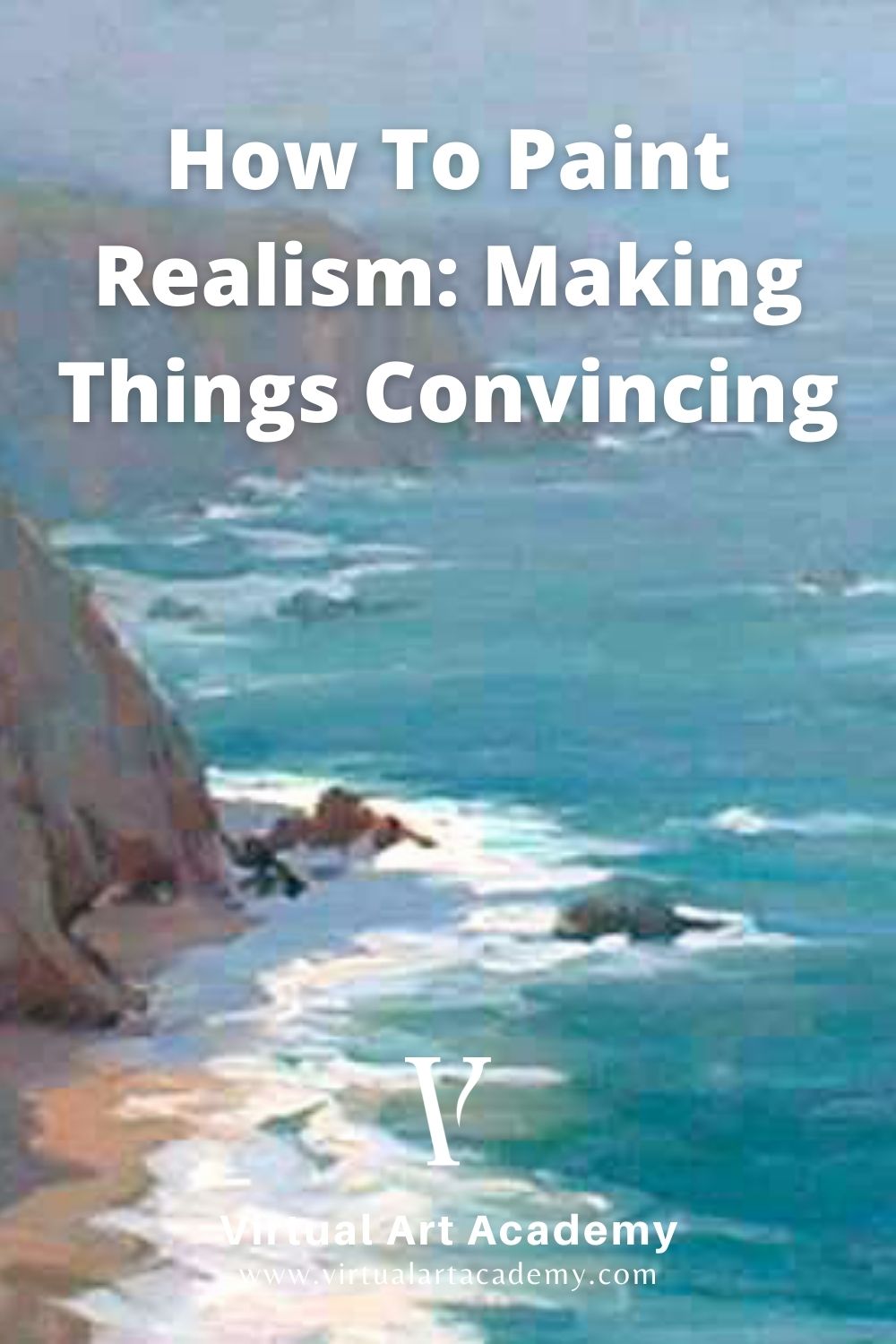
(Get free painting tips and plein air painting techniques sent straight to your inbox or on my social media.)
Whether you are painting landscapes, still lifes, or portraits, eighty percent of the realism in your painting comes from just one thing. So if you are struggling making your paintings look real, this might help you.
How To Paint Realism – Accurate Values
It was an eye-opener for me when learning how to paint realism to discover how important values are. Did you know that 80% of the realism in painting comes from choosing the correct value for each shape and not on how accurately you matched the color? I found that poor values account for most of the reasons why students paintings do not look “real.”
Tip 1: Practice your value scales
So if you want to learn how to paint realism, you need to work on your values. A good way to start is to build a value scale, which is a series of color spots of gradually increasing value. Common value scales are the three, four, five, and nine value scales. As you get more advanced, you can use more values.
If you want to quickly learn how to add realism in your work, I would suggest your start with practicing a four-value scale. The four values are black, white, light grey and dark grey.
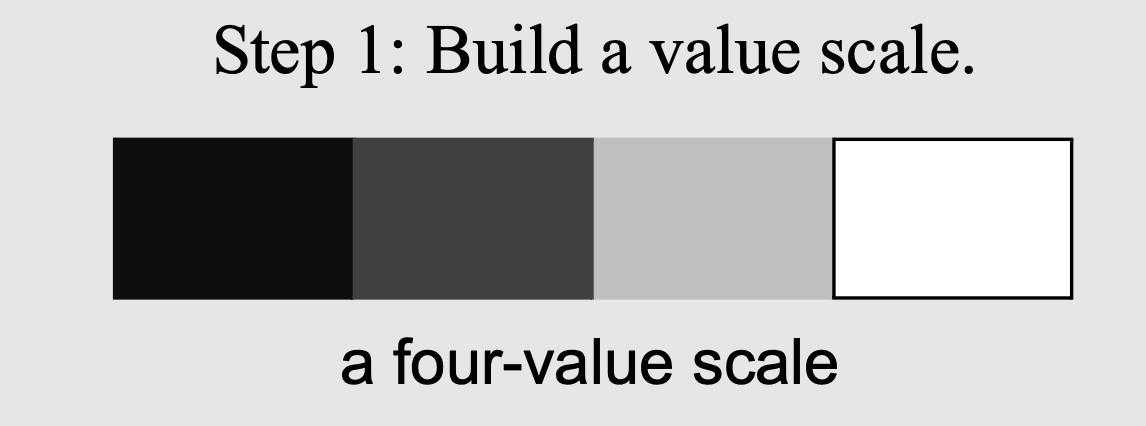
Once you have your value scale, use it as a basis for keeping different shapes in your painting within these values.
Tip 2: Do a small painting in black, white, and grey
In “Big Sur Morning”, a painting I did just a couple of years after I started painting full time professionally, I was trying to capture the moody atmosphere that you get on the Big Sur coast when the fog rolls in.
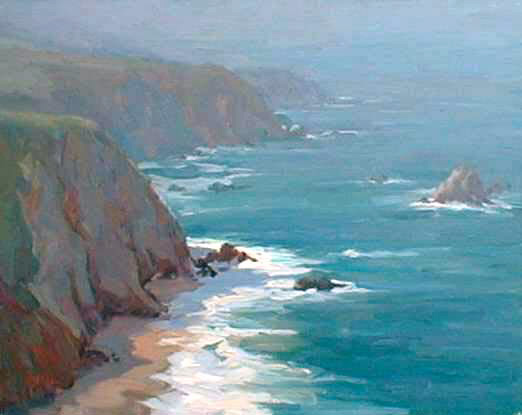
Getting the values correct is critically important when using atmospheric perspective to create depth, and capture the realism in painting.
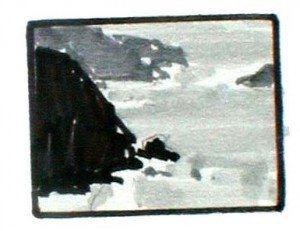
This is the small painting I created using only the four values, in preparation for the final painting. You can see that even though it is only in four values, this small painting has captured the scene, and only took a few minutes to paint using brush pens.
Each of the successive planes of cliffs get lighter in value to give the feeling of depth in the landscape. I discovered this tip for how to paint realism and its role in atmospheric perspective early on. It was this discovery of the role of values in atmospheric perspective that helped make the final painting work and win a top award in the Carmel Plein Air Art Festival many years ago.
Definition Of Realism In Art
Realism is the accurate and detailed depiction of nature or of contemporary life. It is an attempt to represent subject matter truthfully, without any deliberate change for reasons of style, creating some fiction, or showing the supernatural. Realism in art is based on a close observation of the outward appearances of things.
History Of Realism In Art
Historically realism refers to various art currents and movements throughout history. The term has been used to describe diverse artistic currents from many different civilizations. These include ancient Hellenistic Greek sculptures which accurately portray boxers and old women, the works of 17th-century painters such as Caravaggio, and the Dutch genre painters. Later realists were the Spanish painters Diego Velázquez, and Francisco de Zurbarán, followed by mid nineteenth century French painters such as Gustav Courbet and Jean-François Millet. These French artists painted subjects from everyday life in a naturalistic manner. Later artists such as Winslow Homer and Thomas Eakins also painted realistic subjects and continued the tradition.
The term Classical Realism however describes an artistic movement in the late-20th and early 21st century in which drawing and painting place a high value upon skill and beauty. However it could be argued that this is not realism in the true sense since it often depicted an idealized form of beauty, and not subjects as they actually were.
The term can also be used in a general sense to describe paintings that are painted in a realistic almost photographic way as in the photorealist movement in the twentieth century and to the various twentieth century Social Realist Movements in Russia and Germany.
Realism can also be used to distinguish paintings that represent something real from pure abstract work. This latter is the definition I tend to use in my writing.
For Beginners
When you are starting to learn painting, you should spend more time learning how to see values than anything else.
As you develop your value skills, your paintings will get better and better.
If you want to master values start with lessons on Values in our Virtual Art Academy® Apprentice Program. Here you will learn more about value scales, how to see and compare values accurately, and the importance of limited value studies.
To learn more about how to give your paintings depth, see the lessons on Atmospheric Perspective in our Virtual Art Academy® Apprentice Program.
For Intermediate and Advanced artists
To learn how to see color accurately – a critical skill for capturing the feeling of a place or scene, see the lessons on Observation in our Virtual Art Academy® Apprentice Program.
In addition to a change in value, I made a few more subtle changes in the hue and saturation of the colors in each successive planes of cliffs. To learn much more about using these subtle changes to create depth in your paintings, see the lessons on Observation in our Virtual Art Academy® Apprentice Program.
Thank You
Thank you for taking the time to read this article. I hope you find it useful. If you would like to get free painting tips by email, please sign up for my free tips newsletter.
If you are interested in a structured approach for learning how to paint, take a look at my online painting classes.
Happy painting!
Barry John Raybould
Virtual Art Academy
What The Students Are Saying
comprehensive art education

No need to buy expensive art books…. Just do the VAA 4 year course. I still refer to it

Read more “No need to buy expensive art books…. Just do the VAA 4 year course. I still refer to it”
The equivalent of a 4 year art education at a fraction of the cost

Read more “The equivalent of a 4 year art education at a fraction of the cost”
A great learning platform

The most comprehensive, in depth and well-organized painting course available online

Read more “The most comprehensive, in depth and well-organized painting course available online”
Building blocks of learning is the best I have seen

Read more “Building blocks of learning is the best I have seen”
‘Ladder of Learning’ adds to overall positive experience of this awesome course

Read more “‘Ladder of Learning’ adds to overall positive experience of this awesome course”
The small steps are easy to do

The sky’s the limit

The course is for beginners, intermediate and advanced artists

Read more “The course is for beginners, intermediate and advanced artists”
I’m Richard Robinson …. best online art training available on the internet today

In my opinion Barry has created the best online art training available. I found the Virtual Art Academy course of painting lessons many years ago and was so inspired by it that I contacted the author and got to know him personally.
Two Critical Keys
If you are looking (like I did) for the best painting course available there are two key things you should know about the Virtual Art Academy course which make it stand out above the other online painting courses available today:
1. It’s Comprehensive.
It covers ALL the key painting concepts and then goes further, revealing more and more painting insights. Most courses miss a LOT out – this one doesn’t.
2. It’s easy to understand.
All that information could easily become confusing, but each piece is laid out clearly and concisely using Information Mapping® making it a pleasure to learn.
If you can find another painting course which does these 2 things better, please let me know. As I said, I have been searching for many years and continue to do so, so you could save yourself a lot of precious time and money by joining the Virtual Art Academy today.
Read more “I’m Richard Robinson …. best online art training available on the internet today”
It is wild to see how much I am learning in this course!

I retired last year, and decided I wanted to spend my time in retirement learning how to oil paint. But having never painted before, I wasn’t even sure what to look for in an online painting course. However, I did some searches for “Best Online Oil Painting Courses,” and found several references to VAA.
I signed up for VAA’s ongoing Apprentice Program last October (2023), and I am incredibly glad I did! As a beginner, I didn’t know what I didn’t know, but I didn’t have to: VAA has already mapped it all out for me. It starts out with basic, fundamental stuff, but also teaches me the THINKING that goes in the painting: the composition, my color choices, how to consciously select which darks and lights need to be emphasized, etc.
Bottomline, I am learning how to create paintings that have both visual music and poetry, and it is super fun to see my growth! I cannot recommend this course enough!
Read more “It is wild to see how much I am learning in this course!”
Only online learning program I have ever discovered using a training industry best practice
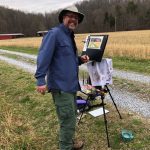
VAA is the only online learning program I have ever discovered using a training industry best practice of incorporating Knowledge and Skills to support learning a new activity. Every building block (Drawing, Form, Observation, Concept, Notan, Composition, Colour, Brushwork) incorporates a “spiral learning” approach where you are introduced to the Knowledge/Skill at one level and then reintroduced to it again elsewhere in the curriculum. Sure genius.
I’ve attended workshops, read books, and watched YouTube videos — and none of them provide the scaffolded approach to learning the VAA offers. If you are just starting your painting journey, start here. If you are a mid level or advanced painter, start here. There is a sense of community with artists around the globe. You are part of a peer to peer learning process bigger than yourself.
As a result of the VAA, I have been juried into several shows, am represented by a local gallery and have been selling my paintings on a consistent basis. VAA curriculum’s approach will grow your ‘artist’s brush’ and aid you in finding your artistic voice. As your basics improve, your art improves. Henry Hensche said, “There is study and there is performance, and we should not confuse the two, study is done for perceptual development, our performances show us where we are in that development, and we must have both…”. VAA curriculum offers both.
I went through the entire curriculum, did every every exercise, and today review my printed books/exercises on an annual basis to keep myself fresh and ready for my next painting adventure.
Onwards/Sideways,
Jay “jbird” Holobach
https://www.jayholobach.com/
It is a real course that trains you in a structured way

Read more “It is a real course that trains you in a structured way”
Since I started the programme I can see improvements in my composition and use of colour

I have been working through the VAA course for over five years and would highly recommend it to anyone wanting to improve their painting. There is a huge amount of information on the site and it is well presented and regularly updated and added to. When other members have commented on work I have posted I have found it really useful. When I review my work over the time since I started the programme I can see improvements in my composition and use of colour.
Read more “Since I started the programme I can see improvements in my composition and use of colour”
The most comprehensive art instruction I could find anywhere online, and trust me, I had been looking for a long time.

The Virtual Art Academy is simply the most comprehensive art instruction I could find anywhere online, and trust me, I had been looking for a long time.
Even art schools and academies I’ve been exposed to are nowhere near as thorough, VAA is just amazing!
Most paintings I see where the artist clearly has some skill still lack in either the values or notan department, or fall down on composition – it’s baffling that VAA seems to be the only program that goes into detail on this. Therefore, if you are new to painting or an experienced artist, studying with VAA will get you to that next step.
I also find that Barry is always interested in what we students do and is at hand with great advice. Worth every penny, Thank you Barry!!
The course has a steady learning curve that keeps revealing itself as you advance

Read more “The course has a steady learning curve that keeps revealing itself as you advance”
Fantastic lesson plans, and a vibrant community
The Virtual Art Academy is the perfect art course I’ve been searching for. Barry’s decades of knowledge are condensed into fantastic lesson plans, creating a vibrant community. The apprentice course delves deep into drawing, painting planning, and color theory. It’s like obtaining an art degree at my own pace and more affordably. The structured format encourages interaction and feedback, enhancing the learning experience. Overall, a fulfilling way to study art from home.
What I learned from 10 years with VAA

It does mean you have to look at things differently in the beginning but it is really exciting to learn a new, simpler way of painting- its all about VALUES!!!
It all seems a bit strange, making Notans, outline studies, value studies all in greys, colour maps, ie not painting a pretty picture in colour, but you must trust the experts and just do it. It’s all about being able to see the big shapes and values which takes, in my case, a long time for the brain to learn how to do. Once you see, it the lightbulb goes on and everything clicks into place.
Be patient, do the exercises, trust the process and you will get good results. I did as Barry suggested and just worked through the exercises in my sketchbook from life, I didn’t paint pictures for long time. I stayed on values studies for a very long time and found I was enjoying painting again.
It’s ok to take your time. Just keep working and try to find a routine for studying, keep at it. After a long time working like this I am now getting pictures into Art Societies in London (The Chelsea Art Society and the The Mall Galleries- RBA, NEAC and Pastel Society) selling them and even winning prizes. I’ve joined Plein Air groups in London and Surrey (which are free) met and made new friends and am part of a community of like-minded artists which is important to me and makes me happy.
Georgie Rey
https://www.artmajeur.com/georgina-rey
I started learning oil painting with VAA from scratch. Just one year later my paintings started to sell

An excellent foundation on so many aspects of painting

When I got word of the course available through Virtual Art Academy, I was very excited for the opportunity to learn what I never knew about painting. VAA has provided me an excellent foundation on so many aspects of painting. The course is organized very logically, provides great examples, diagrams, thorough explanations and worthwhile assignments. I highly recommend this course to anyone with a desire for an in-depth education of art.
Thank you again, Barry, I love this course Jeanne
Read more “An excellent foundation on so many aspects of painting”
First quality education, materials, layered learning systems, feedback loop and social support and lifelong learning – amazing
Thank you again for such an amazing program and opportunity. I wish you continued and even greater success. You have contributed to many many people… thank you from all of us.
This is a far more superior school than anything I have seen being taught at colleges across the country

It is impossible to fail or gain little through extensive 4 year study at VAA!
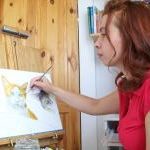
Read more “It is impossible to fail or gain little through extensive 4 year study at VAA!”
VAA, the ultimate art course
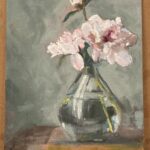
Barry gave me a fishing rod so I can catch my own fish

Read more “Barry gave me a fishing rod so I can catch my own fish”
The improvement in my own work reaffirms that I’ve found the right program to develop as an artist

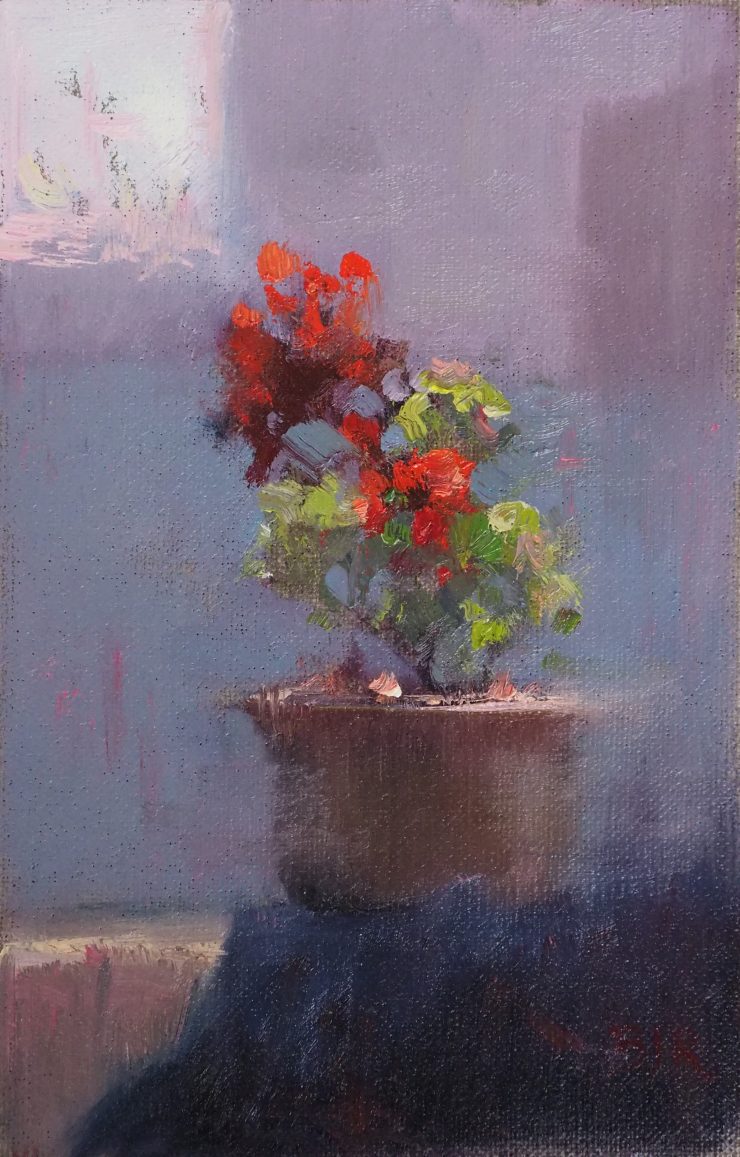
Add comment